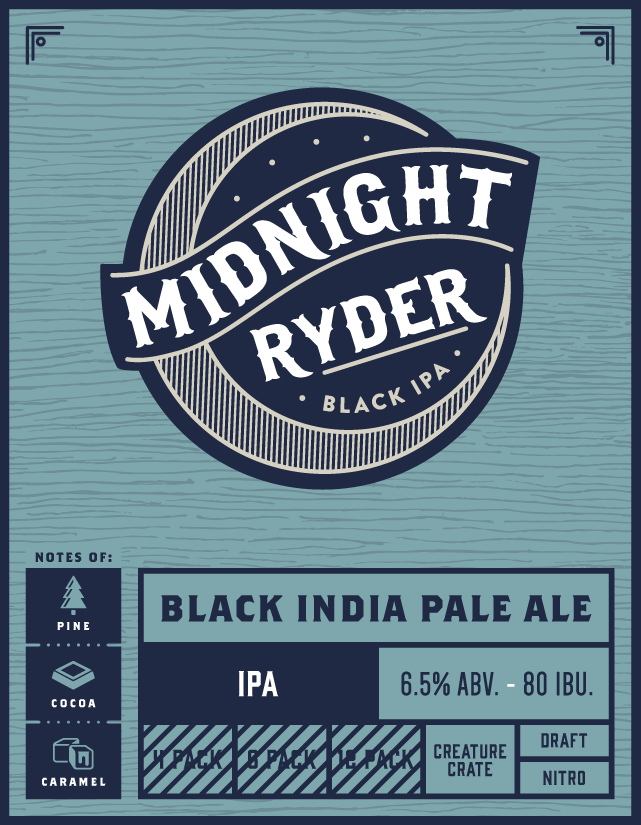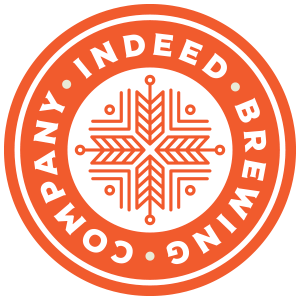
Recipe: Midnight Ryder
5 Gallon Extract Batch
When the clock strikes Midnight Ryder, complex notes of chocolate, caramel, and roast collide with six varieties of American hops to create a resinous, piney, Black IPA. After Midnight, expect the unexpected.
O.G: 1.061
Ready: 5 Weeks
Fermentation Schedule:
1–2 week primary
1 weeks secondary
1-2 weeks bottle conditioning
Specialty Grain:
- 0.75 oz Black Patent Malt
- 0.75 oz Chocolate Malt
- 0.5 lb Briess Caramel 80L
- 0.25 oz Briess Caramel 120L
Extracts & Other Fermentables:
- 6 lbs Gold malt syrup
- 1 lb Golden Light DME (5 min late addition)
Boil Additions:
- 0.5 oz Willamette (First Wort - 90 min)
- 0.5 oz Glacier (30 min)
- 0.5 oz Willamette (30 min)
- 1.5 oz Cascade (20 min)
- 1.5 oz Glacier (20 min)
- 0.5 oz Willamette (20 min)
- 1 oz Apollo (10 min)
- 1 oz Columbus (10 min)
- 0.5 oz Summit (10 min)
- 0.75 oz Apollo (3 day dry hop)
- 0.75 oz Cascade (3 day dry hop)
- 0.75 oz Columbus (3 day dry hop)
- 0.75 oz Glacier (3 day dry hop)
- 0.75 oz Summit (3 day dry hop)
- 0.75 oz Willamette (3 day dry hop)
Yeast Options:
Dry yeast: Safale US-05. Optimum temperature: 67°F
Liquid yeast: Wyeast #1272 American Ale II. Optimum temperature: 67°F
Priming Sugar - 5 oz Priming Sugar (for Bottling Day)
Brewer's Note - This recipe calls for a 90 minute boil
On Brewing Day
Collect and heat 2.5 gallons of water.
Pour crushed grain into muslin bag and tie the open end in a knot. Steep for 20 minutes or until water reaches 170°F. Remove bag and discard.
Once the muslin bag of grains is discarded, add 0.5 oz Willamette hops to kettle and bring wort to a boil.
Once boiling, remove the kettle from the burner to stir in the 6lbs Gold malt syrup. Add hot wort to malt container to get as much syrup out as possible.
Return wort to boil.
Add 0.5 oz Glacier hops and 0.5 oz Willamette with 30 minutes remaining in the 90 minute boil.
Add 1.5 oz Cascade, 1.5 oz Glacier, and 0.5 oz Willamette hops 20 minutes before the end of the boil.
Add 1 oz Apollo, 1 oz Columbus, 0.5 oz Summit with 10 minutes remaining in the 90 minute boil.
Add 1 lb Golden Light DME 5 minutes before the end of the boil.
Remove from heat when 90min boil is complete.
Cool the wort. When the 90-minute boil is finished, cool the wort to approximately 64° F as rapidly as possible. Use a wort chiller, or put the kettle in an ice bath in your sink.
Sanitize fermenting equipment and yeast pack. While the wort cools, sanitize the fermenting equipment – fermenter, lid or stopper, fermentation lock, funnel, etc – along with the yeast pack and a pair of scissors.
Fill primary fermenter with 2 gallons of cold water, then pour in the cooled wort. Leave any thick sludge in the bottom of the kettle.
Add more cold water as needed to bring the volume to 5.25 gallons.
Aerate the wort. Seal the fermenter and rock back and forth to splash for a few minutes, or use an aeration system and diffusion stone.
Measure specific gravity of the wort with a hydrometer and record.
Add yeast once the temperature of the wort is about 64°F. Use the sanitized scissors to cut off a corner of the yeast pack, and carefully pour the yeast into the primary fermenter.
Seal the fermenter. Add approximately 1 tablespoon of sanitizer water to the fermentation lock. Insert the lock into rubber stopper or lid, and seal the fermenter.
Move the fermenter to a dark, quiet spot until fermentation begins.
Active fermentation begin within approximately 48 hours of Brewing Day, there will be a cap of foam on the surface of the beer, and you may see bubbles come through the fermentation lock.
Secondary Fermentation
Approximately 1-2 weeks after brewing day, active fermentation will end: the cap of foam falls back into the new beer, bubbling in the fermentation lock slows down or stops.
Take a hydrometer reading until the SG does not drop for 2 consecutive days.
As soon as gravity remains stable for 2 consecutive days, transfer beer to secondary fermenter. Sanitize siphoning equipment and an airlock and carboy bung or stopper. Siphon the beer from the primary fermenter into the secondary.
Secondary fermentation. Allow the beer to condition in the secondary fermenter for 1 week before proceeding with the next step. Timing now is somewhat flexible.
Add the dry hops. Add 0.75 oz Apollo, 0.75 oz Cascade, 0.75 oz Columbus, 0.75 oz Glacier, 0.75 oz Summit and 0.75 oz Willamette to the secondary fermenter 3 days before bottling day.
Bottling Day
Sanitize bottles, siphoning and bottling equipment.
Mix a priming solution (a measured amount of sugar dissolved in water to carbonate the bottled beer) of 2/3 cup priming sugar in 16 oz water. Bring the solution to a boil and pour into the bottling bucket.
Siphon beer into bottling bucket and mix with priming solution. Stir gently to mix, don’t splash.
Fill and cap bottles.
1–2 Weeks After Bottling Day
Condition bottles at room temperature for 1–2 weeks. After this point, the bottles can be stored cold.
- Serving. Pour into a clean glass, being careful to leave the layer of sediment at the bottom of the bottle.

